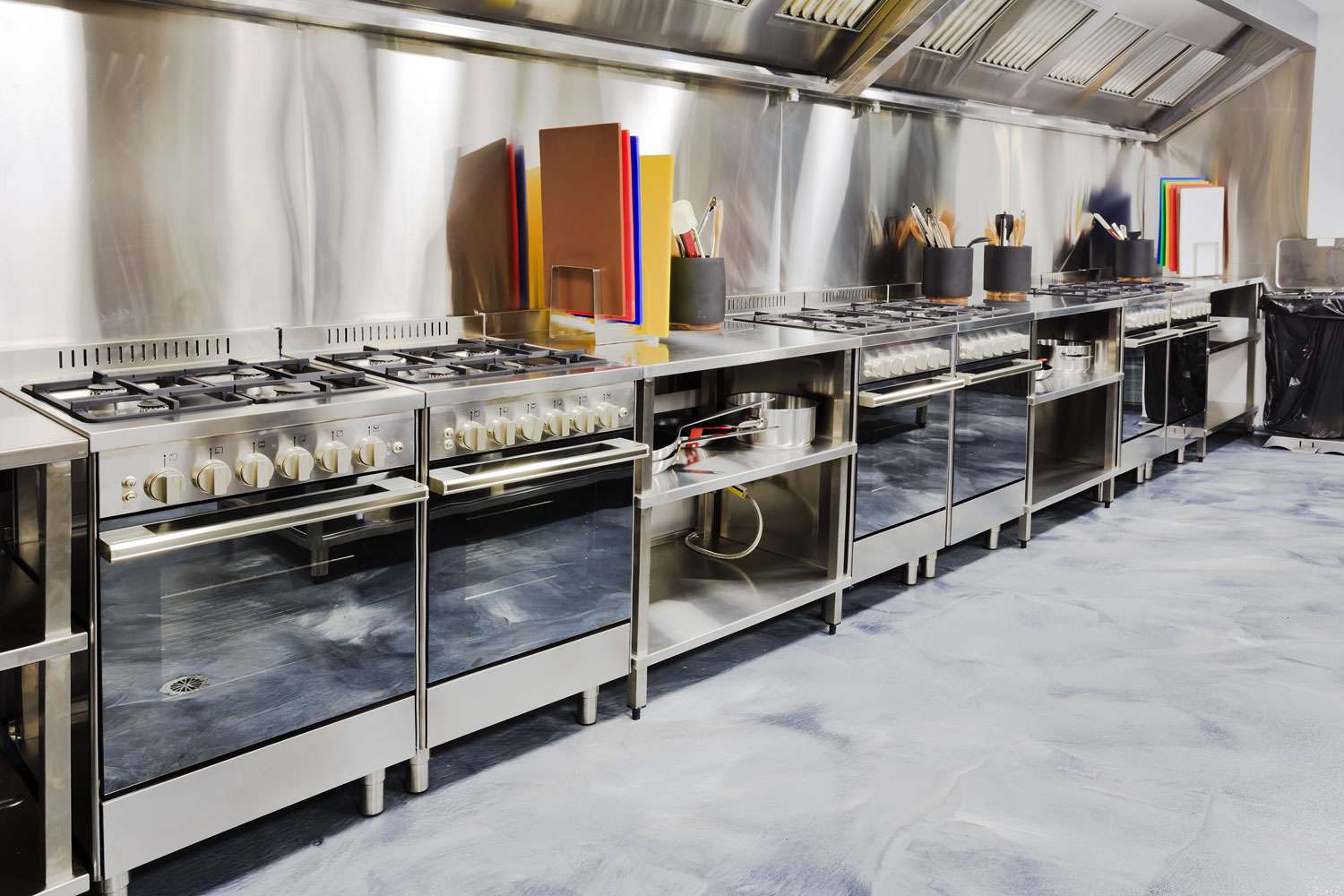Floor Care: Tips and Tricks for Maintaining Non-Slip Commercial Kitchen Floor
Commercial kitchen floors get constant foot traffic, spills, grease, and food debris, often making them slippery and hazardous. Keeping your commercial kitchen clean, including the floors, is a constant responsibility—not only for employee safety and to maintain standards of cleanliness for your diners, but also to comply with health regulations. As this can be time consuming, we’ve put together these tips and tricks to help you manage this important, regular task.
Table of Contents:
- How Restaurant Kitchen Floors Get Dirty
- Tips to Keep a Commercial Kitchen Floor Non-Slip and Clean
- How to Clean a Restaurant Kitchen Floor
- How To Clean A Greasy Restaurant Kitchen Floor
- How to Deep Clean a Kitchen Floor
- More Tips for Commercial Kitchen Floor Cleaning
- Hire a Professional Commercial Kitchen Cleaning Service
How Restaurant Kitchen Floors Get Dirty
Commercial kitchen floors accumulate dirt and grime from various sources, including:
- Food and Beverage Spills: Spills from cooking ingredients, oils, sauces, and beverages can quickly soil the floor.
- Grease and Oil Splatters: Cooking activities produce grease and oil splatters that can spread across the floor surface.
- Foot Traffic: Constant movement of kitchen staff can track dirt, food particles, and moisture onto the floor.
- Lack of Regular Cleaning: Infrequent or improper cleaning routines allow dirt and grime to build up over time, leading to stubborn stains and residues.
Tips to Keep a Commercial Kitchen Floor Non-Slip and Clean
Preventative measures are key to minimizing dirt and grime buildup on commercial kitchen floors:
- Use Mats and Rugs: Place non-slip mats or rugs in high-traffic areas and near sinks and cooking stations to trap dirt and moisture.
- Implement Shoe Policies: Enforce footwear policies that require kitchen staff to wear slip-resistant shoes and to clean their shoes before entering the kitchen.
- Prompt Spill Cleanup: Immediately clean up spills to prevent them from spreading and becoming difficult to remove.
- Regular Sweeping and Mopping: Establish a daily cleaning routine that includes sweeping and mopping to remove loose debris and spills.
How to Clean a Restaurant Kitchen Floor
Follow these steps to effectively clean a restaurant kitchen floor:
- Clear the Area: Remove any obstacles and debris from the floor to facilitate thorough cleaning.
- Floor Drains: Ensure the floor drains are clear so water can drain once you start cleaning
- Sweep or Vacuum: Use a broom or vacuum cleaner to remove loose dirt, debris, and food particles from the floor surface.
- Pre-Treat Stains: Apply a degreasing cleaner or detergent to stubborn stains and grease spots. Allow the cleaner to penetrate for a few minutes.
- Mop with Hot Water and Cleaner: Fill a bucket with hot water and add a commercial kitchen floor cleaner according to the manufacturer’s instructions. Use a mop to thoroughly clean the floor, paying extra attention to high-traffic areas and grease-prone zones.
- Rinse with Clean Water: After mopping, rinse the floor with clean water to remove any remaining cleaner residue.
- Dry the Floor: Use a clean, dry mop, squeegee, or towels to dry the floor surface to prevent slips and falls.
How To Clean A Greasy Restaurant Kitchen Floor
Cleaning a greasy restaurant kitchen floor requires thoroughness and attention to detail to ensure a safe and hygienic environment. Follow these steps for effective grease removal:
- Sweep the Floor: Sweep or vacuum the floor to remove loose debris and food particles.
- Use Degreaser: Apply a degreasing cleaner or detergent to grease stains and heavily soiled areas. Let it sit for several minutes to loosen the grease.
- Scrub the Floor: Scrub the floor using a stiff-bristled brush or floor scrubber to agitate the grease and dirt.
- Rinse: Rinse the floor thoroughly with hot water to remove the loosened grease and cleaner residue.
- Repeat as Necessary: Repeat the scrubbing and rinsing process as needed until the floor is clean.
- Let Dry: Dry the floor completely using a mop or towels to prevent slips and falls.
How to Deep Clean a Kitchen Floor
Deep cleaning is essential for removing stubborn stains, grease buildup, and embedded dirt. Follow these steps for a thorough deep clean:
- Clear the Area: Remove all equipment, furniture, and obstacles from the floor to access every corner.
- Cleaning Solution: Prepare a restaurant floor cleaner by diluting a heavy-duty degreaser or alkaline cleaner with water.
- Scrubbing Brushes: Use stiff-bristled scrubbing brushes or a floor scrubbing machine to agitate the cleaning solution and loosen stubborn dirt and grease.
- Spot Treatment: Focus on areas with heavy grease buildup and stains, applying extra scrubbing pressure as needed.
- Rinse and Dry: After scrubbing, rinse the floor thoroughly with clean water to remove the cleaning solution and residue. Use a wet vacuum or mop to remove excess water, and allow the floor to air dry completely.
More Tips for Commercial Kitchen Floor Cleaning
- Use Non-Slip Floor Coatings: Apply non-slip floor coatings or sealants to enhance traction and reduce the risk of slips and falls.
- Regular Maintenance: Implement a regular maintenance schedule that includes daily sweeping and mopping, weekly deep cleaning, and periodic resealing of the floor surface.
- Address Grout Lines: Pay attention to grout lines between tiles, as they can harbor dirt and grime. Use a grout brush and cleaner to scrub and maintain cleanliness.
- Professional Cleaning Services: Consider hiring a professional commercial kitchen cleaning service for thorough deep cleaning and maintenance, especially for large kitchens or when deep cleaning is required.
Hire a Professional Commercial Kitchen Cleaning Service
For the most thorough and efficient cleaning of your commercial kitchen floor, consider hiring a professional cleaning service. Safe Kitchens has the expertise, specialized equipment, and commercial-grade cleaners to deep clean and maintain your kitchen floor to the highest standards.
By implementing regular cleaning routines, addressing spills promptly, and investing in professional cleaning services when needed, you can maintain a safe and sanitary environment for your staff and customers.
Whether you’re looking to prevent slips and falls, remove stubborn stains, or ensure compliance with health regulations, following these tips and tricks for maintaining a non-slip commercial kitchen floor will help you achieve optimal results.

